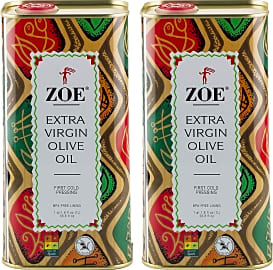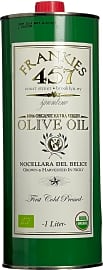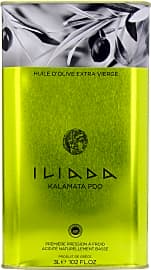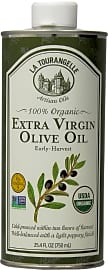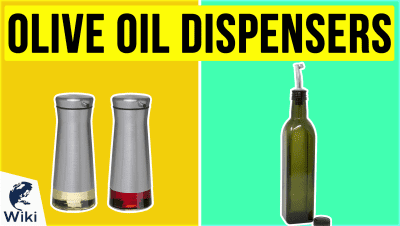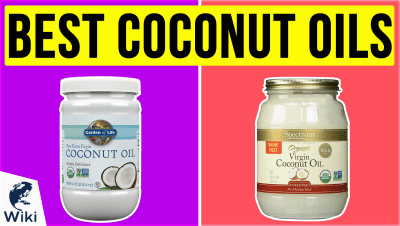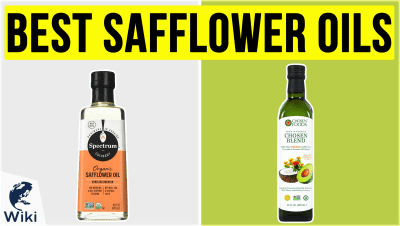The 10 Best Olive Oils

This wiki has been updated 43 times since it was first published in April of 2016. Not just a great way to add flavor to many dishes, olive oils are also considered an excellent heart-healthy source of fats. Whether you lean toward a certain region, such as Greece, Italy, or Spain, or demand your ingredients be insecticide, herbicide, and pesticide-free, we've included well-balanced choices that will provide everything from a subtle to a robust taste. When users buy our independently chosen editorial recommendations, we may earn commissions to help fund the Wiki.
Editor's Notes
July 09, 2020:
For this update, we wanted to keep the variety we had previously but introduce a new brand or two to speak to evolving tastes or unmet needs. You'll still find options from Spain, Italy, and Greece, as well as a Portuguese addition with Zoe First Cold Pressing, which uses Portuguese olives but is packed in Spain for its 2020 harvest. California Olive Ranch Everyday is still a fan favorite among many, but it no longer comes exclusively from California like it used to. As part of its new "destination series," it now uses a blend sourced from a handful of locales, which some are not a fan of.
We also noticed that up until now, our list has mostly focused on Extra Virgin or otherwise high-end varieties, and figured it would be useful to recommend a solid budget-friendly option for cooking and frying, which you would never use a high-grade olive oil for. Alongside the Bertolli brand, Pompeian Extra Light Tasting is an excellent choice for everyday use in preparing dishes like stir-fry and seafood, where you want the oil to fly under the radar.
One downside is that it comes in a clear plastic bottle, which allows light in and can adversely affect the taste of the oil. If you're worried about the integrity of your selection, picking up a dedicated olive oil dispenser might be a good idea.
June 21, 2019:
You'll find olive oils sourced from Greece, Spain, Italy, France, and the United States in our latest update. We included light, medium-bodied selections as well as bold varieties, and prioritized expertise, flavor, price, and quality control when it came to the options on our list. We also wanted to strike a balance between oils for everyday cooking and special occasions.
For finishing, Agrumato Lemon is hard to beat. Its bright, fresh taste lends itself well to endless dishes, and a little goes a long way in imbuing flavor. It comes in a dark glass canister that helps keep light out to preserve its freshness, and it's not overly difficult to pour, like some other containers. We felt Agrumato's enticing flavor profile was enough to unseat Baja Precious.
Since our previous #5 pick, Trader Joe’s California Estate, became unavailable, we took the opportunity to recommend Papa Vince Harvest. It is extracted with care, comes from one source, and is pressed in a mill that only ever touches olives. It's got a crisp, clean taste and is free and clear of any pesticides and herbicides.
While all the options on our list undergo rigorous quality control processes, Ellora Farms Certified PDO and PJ Kabos Greek Extra Virgin take things further with transparency regarding their manufacturing process and multiple awards, respectively.
For something a little intense, try La Tourangelle Extra Virgin, while Kirkland Signature Organic Extra Virgin is a reliable organic option that's affordably-priced and rests a step above bargain brands like Bertolli, Pompeian, and Colavita.
Special Honors
Brightland CA The Duo A recent up-and-comer in the industry, Brightland is known for its sustainably-produced, small-batch oil pressed by master millers from single-origin heirloom olives. Each glass bottle is UV-powder coated to protect the contents and marked with a harvest date. This subscription includes the "Awake" and "Alive" varieties in 12.7 fl oz bottles that ship every one, two, or three months. brightland.co
Il Tratturello Il Tratturello is for those who love intense, bold flavors. Crafted in Piani di Larino, it is produced using organic, sustainable methods of composting and fertilizing. Olives are hand-picked between October and November and pressed within a few hours of harvest. The yields are sold in limited quantities and come in hand-numbered bottles, and the taste is spicy and slightly bitter. gustiamo.com
Le Chateau d'Estoublon Beruguette Hailing from Provence, France, Le Chateau d'Estoublon is best used with braised fish and poultry, or to add depth of flavor to spiced cakes. It has a distinct spicy taste with plenty of bitter notes, as well as touches of hazelnut and almond. It is a mono-variety oil, pressed exclusively from French Beruguette olives. oliveoillovers.com
Olive or Let Die
Known for its versatility, it can be used as a meal, skin treatment, fuel for lamps, and much more.
Olive oil is a staple commodity found in homes, restaurants, and religious institutions all over the world. Known for its versatility, it can be used as a meal, skin treatment, fuel for lamps, and much more. The biggest claim to fame, however, is olive oil used for enhancing foods. Primarily in Italian and Greek cooking, olive oil is essential when it comes to making a meal complete.
The oil comes from the fat of the olive. Despite the constant grouping with vegetables, olives are actually a stone pit fruit, similar to a cherry or plum. You can think of olive oil as a cold pressed juice from a fruit. The process of extracting the oil from the olive is called pressing and it is done at an olive mill. Olives must be pressed at the right maturity; young green olives make for a bitter oil while overripe olives are rancid. That is also the distinction between green and black olives. Green olives are simply immature black olives.
There are two ways of pressing olives: cold pressed or mechanically pressed. The cold press is a method that does not use chemicals to artificially heat the olives to extract more oil. The term cold is a bit of a misnomer; they are not pressed cold, but rather at temperatures lower than 81 degrees. Only olives that have first undergone this cold press process can be labelled as extra virgin olive oil. Extra virgin olive oil, or EVOO, also means that it has less than 0.8% acidity, and it has been flavor tested to ensure quality. The price of EVOO will be reflected in the quality as well. EVOO should be used as a finishing oil, and not wasted on deep frying items.
Fine, or virgin olive oil, has an acidity of less than 2%. Also, it has been heated by chemical means to extract more oils at a higher temperature, however, doing so alters the flavor profile and can destroy the natural aromas as well. Virgin olive oil will be comprised of lower quality olives and may contain a flavorless profile.
What To Keep an Eye Out For
The organic food trend has everyone running for the fair trade olive. You must, however, keep a vigilant eye when purchasing your oil, as some may be mislabeled. The prime example is oils that say Imported from Italy, which can be skewed in such a way to distract you from knowing the oil was actually produced in Turkey, Spain, or Morocco. The International Olive Council (IOC) ensures that oils are labelled appropriately. Although the United States does not adhere to the IOC, they have their own council with comparable rules.
As the economy improved in Europe, the Mediterranean diet began to include fatty meats and sugars.
As mentioned before, EVOO is the highest standard followed by virgin olive oil. Virgin oil is still good quality and it is of better quality than refined or blended oil. The oil you decide to purchase should be reflected in its use. For example, an extra virgin oil would not be appropriate for deep frying foods, nor would a pomace oil to dress an expensive salad.
Whichever one you purchase, keep in mind that oil has a relatively short shelf life. Use within the first six months of purchasing it for optimal taste. Oil differs from wine, which gets better with age. Also, be careful of spoilage. Olive oil is very delicate to light. The oil on the table of your favorite chain Italian restaurant may already be spoiled from the harsh overhead light.
Many consumers are attracted to olive oil for the health benefits. The Mediterranean diet has been praised time and time again for this reason. It became a huge fad in the 1950s in America; however, most Americans were misinformed. The Mediterranean diet in Greece was for the poor and not an option; they simply could not afford to buy meat. As the economy improved in Europe, the Mediterranean diet began to include fatty meats and sugars. Currently, most Europeans want to mimic the American diet, which is high in sugar and fats. The irony is palpable.
History of Olives
The history of olives predates history itself. There is recorded evidence that as early as 6000 B.C.E., olives were being plucked off of olive trees for consumption. The religious uses of olive oil are not exclusive to one faith. Judaism, Islam, and Christianity all embrace the olive and olive oil for religious significance. The most obvious example is the olive branch delivered to Noah by a dove when the Great Flood had subsided, and the olive branch began to stand as a symbol for peace and reconciliation.
Olive oil was found at tomb sites in Egypt over 2,000 years ago.
It is among the oldest cultivated trees grown in the Asia Minor area. The civilizations of Phoenicia, Iran, and Persia embraced the wonders of olive oil, as did the Egyptians. Olive oil was found at tomb sites in Egypt over 2,000 years ago. Olive oil was then popularized by the Greeks, who added it to a staple in their diet. They also used the oil to anoint athletes and warriors.
The Romans conquered Greece and like many other things the Greeks invented, the Romans incorporated it into their daily lives. From there, the reputation of olive oil spread worldwide, and began to be incorporated into world religions. The prophet Muhammad of Islam recommend one bathe oneself in the oil in the Quran.
It was introduced to the New World most notably when the Franciscan friars were sent from Spain in the 1700s to establish missions. As another benefit, they planted olive trees along the California coast. Today, California is now the number one exporter of olive oil in America, yet it only accounts for less than 1 percent of the world market. Spain, Italy, and Greece make up the lion's share of oil production. As consumers continually grow wiser over the food they consume, olive oil should be no different. Treat yourself to quality oil for your meals.


